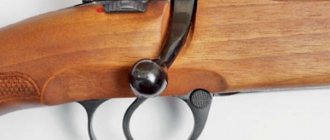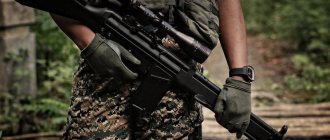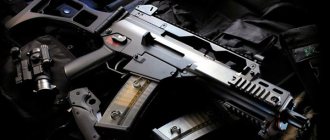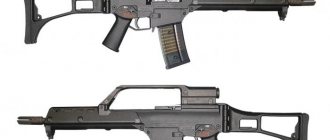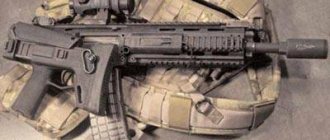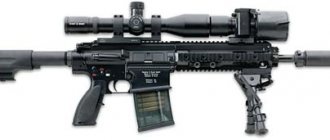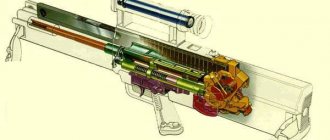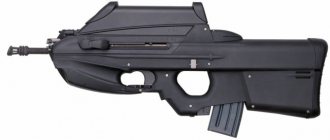Assault rifle (automatic) Beretta AR-70/223 and AR-70/90 (Italy)
Beretta AR-70/223
Beretta SCS-70/223 short carbine - cross-sectional view
Beretta AR 70/90 assault rifle. Installing the folding stock shown below will convert it into an SC-70/90 carbine
Shortened Beretta SCP 70/90 carbine for airborne troops and armored vehicle crews. separately shown is a removable adapter - a muzzle for launching rifle grenades from the barrel
| AR-70/223 | AR-70/90, SC-70/90 | SCP-70/90 | |
| Caliber | 5.56x45mm M193 | 5.56x45mm NATO (SS109/M855) | |
| Length | 995 mm | 998 mm 756 mm SC-70/90 with stock folded | 908 mm 663 mm with stock folded |
| Barrel length | 450 mm | 450 mm | 360 mm |
| Weight without cartridges | 3.8 kg | 4.07 kg | 3.80 kg |
| Magazine capacity | 30 rounds | ||
| Rate of fire | 650 rounds per minute | 670 rounds per minute | |
| Effective range | 400 meters | 500 meters | 350 meters |
The oldest and largest Italian arms company, Pietro Beretta Spa, began developing a new 5.56mm assault rifle in 1968. The rifle was ready by 1972, and under the designation Beretta AR-70/223 began to enter service with Italian special operations forces, and was also exported (to Jordan, Malaysia and a number of other countries). In the early 1980s, the Italian Army decided to replace the outdated 7.62mm Beretta BM59 automatic rifles with a new model of 5.6mm NATO caliber, for which a competition was announced. Samples from various companies were submitted to this competition, including Franchi (licensed HK G41 rifle), SOCIMI, and Beretta. The Beretta model was an AR-70/223 rifle, modernized based on operating experience, and was introduced in 1985. And in 1990, the new Beretta assault rifle was officially adopted for service under the designation AR-70/90. In addition to the basic model, the following were created on its basis: a carbine for special operations forces SC-70/90 with a folding stock, a shortened carbine for airborne troops and crews SCP-70/90 combat vehicles and AS-70/90 light machine gun. Based on the AR-70/90 rifle, only a self-loading version is also produced specifically for the civilian and police markets (a similar version of the earlier AR-70/223 model was called Beretta 70/223 Sporter). Production of AR-70/223 series rifles was discontinued back in the 1980s, and AR-70/90 series rifles are still in production, are in service with the Italian Armed Forces and are offered for export.
Technical description. The AR-70/90 series rifles are automatic, magazine-fed, gas-operated weapons.
The receiver of the AR-70/90 rifle is made of two halves, upper and lower, made by stamping from a steel sheet. For AR-70/223 rifles, the upper part of the receiver had a rectangular cross-section, and the guides for the bolt carrier were stamped into its walls. This design provided insufficient rigidity. and therefore, on the AR-70/90 rifles, the upper part of the receiver received a trapezoidal shape, with steel guides for the bolt frame welded inside. The receiver halves are connected by two transverse pins, at the front and rear.
The automatic gas engine has a long-stroke piston located above the barrel. The return spring is located around the gas piston rod, in front of the receiver. The piston rod is fixed in the bolt frame using the bolt cocking handle. The bolt of a traditional design, similar to the bolt of a Kalashnikov assault rifle, locks the barrel by turning two lugs behind the barrel coupling welded into the receiver. The barrel is also attached to the same coupling using a special union nut. This scheme allows, in field workshops, to quickly change damaged barrels without the need for a long and precise adjustment of the distance between the breech end of the barrel and the bolt mirror. On the gas chamber there is a two-position gas regulator (modes for firing in normal and severe conditions), and a separate gas duct cut-off device connected to a sight for rifle grenades. When this sight is raised to the working position, the gas exhaust path is automatically completely closed.
The trigger mechanism is of a traditional design. On the AR-70/223, it allowed single fire and bursts, and was controlled by a safety lever on the left side of the receiver. It is also possible to install a module on the AR-70/90 that allows an additional firing mode in bursts of 3 shots. The safety-translator lever is located on both sides of the receiver. The lower part of the AR-70/90 trigger guard folds down, which allows the weapon to be fired while wearing winter gloves or mittens.
The rifles are fed from detachable box magazines with 30 rounds of ammunition. The AR-70/223 series rifles had their own standard magazines, and the magazine latch was located behind the receiver, in front of the trigger guard (similar to a Kalashnikov assault rifle). The AR-70/90 series rifles have a magazine receiver designed to accept NATO standard M16 rifle magazines, and have magazine release buttons on both sides of the magazine receiver.
Sights include a front sight with protective “ears” mounted on a gas block, and a reversible L-shaped diopter rear sight with settings for ranges of 250 and 400 meters. In addition, on the top surface of the rifles there are mounts for optical or night sights. AR-70/90 series rifles can be equipped with 4X day optics from Aimpoint or Orion night sight from Zeiss. In addition, it is possible to install adapters for any other sights. AR-70/90 series rifles are additionally equipped with quick-change carrying handles mounted on optic mounts. The base of the handle has longitudinal windows that allow the use of standard rifle sights.
In the basic AR-70/90 configuration, the rifle has a non-folding plastic stock and plastic fittings. The hollow pistol grip contains a set of accessories for cleaning the rifle. The SC-70/90 carbines differ only in the side-folding metal butt of a skeletal design, while the SCP-70/90 carbines also have a shortened barrel. Launching rifle grenades directly from the barrel of a weapon is possible with the AR-70/90 and SC-70/90; for the SCP-70/90, it is necessary to install a special quick-release adapter on the barrel - an extension. Rifles of the AR-70/90 series are equipped with a gun belt, a bayonet, it is additionally possible to install a quick-release lightweight folding bipod and a number of other options.
History[edit]
In 1968, the Italian company Beretta began developing an assault rifle chambered for 5.56x45 mm. The new weapon was supposed to partially replace the Beretta BM 59 automatic rifles in the Italian army. The machine, designated Beretta AR-70/223, began to enter service with special operations forces in 1972.
In the early 1980s, a competition was announced for a new machine gun that would replace the BM59 and AR-70/223 in the armed forces. Franchi, SOCIMI and, in 1985, Beretta, whose prototype was a modernized version of the Beretta AR-70/223, presented their samples. In 1990, the AR-70/90 assault rifle was adopted by Italy, after which export deliveries began.
In 2009, the new ARX-160 assault rifle began to enter service, gradually replacing the AR-70/90.
Operating countries[edit]
Select a country or scroll your mouse wheel
- Albania - 5,000 units. donated to the armed forces from Italy.
- Burkina Faso is in service with the police.
- Honduras - 1,000 units. transferred in 2006
- Egypt - for use by the police.
- Zimbabwe
- India - adopted by the National Security Guard (NSG).
- Indonesia - for use with naval special forces.
- Jordan - SC70/223 standard special forces carbine since the 1980s.
- Italy - 105,000 AR70 and 15,000 SCP70 for the army; The machine gun is also used by the Navy, Air Force, Carabinieri, financial security and police. They are being systematically replaced with ARX-160.
- Lesotho
- Libya
- Malaysia
- Morocco
- Mexico
- Nigeria
- Paraguay
Construction[edit]
AR-70/223[edit]
The operation of the AR-70/223 automation is based on the removal of powder gases from the barrel. In general, the design of the trigger trigger and gas engine is similar to the Kalashnikov assault rifle, and the “breakable” receiver is similar to the FN FAL and M16. The gas piston has a long stroke. The barrel is locked by turning the bolt onto two lugs. The gas chamber has a two-position gas regulator, which allows you to switch between firing modes in normal and difficult conditions, as well as a gas cut-off valve connected to the sight for rifle grenades and closing the path when the sight is raised to the working position. The firing mode safety lever is located on the left side of the receiver and allows you to fire single shots and continuous bursts. The stamped receiver is made of two halves connected by two transverse pins. The stock and accessories are made of plastic.
The sighting device consists of a front sight located on the gas chamber and a diopter rear sight, which has 2 flip flaps corresponding to firing distances of 250 and 400 meters. The cleaning accessory is located in the pistol grip. The machine gun can use a bayonet and a folding bipod.
AR-70/90[edit]
To increase reliability in the AR-70/90, the bolt guides were welded inside the receiver, which in turn received a trapezoidal shape instead of a rectangular one. The principle of attaching the barrel to the receiver has also been changed: instead of a threaded connection, the barrel is attached to the hole in the receiver with the flat surface of the breech using a coupling and collar. The automatic gas release, gas regulator and rotary bolt are similar to those of the AR-70/223. The fuse-translator flag is located on both sides of the receiver and allows firing in single shots and bursts (continuous and with a cutoff of 3 shots). When using a weapon with thick gloves, the shooter can fold back the trigger guard. The magazine socket complies with the STANAG 4179 standard, so the AR-70/90, unlike the AR-70/223, can accept M16 magazines. A carrying handle is attached to the top of the receiver, equipped with an aiming device with a luminous mark, designed for shooting in low light conditions. Instead of a handle, a Picatinny rail can be installed. The sight is a two-position diopter, with a sighting line 555 mm long.
Options and modifications[edit]
- AR-70/223
- basic version with a fixed stock.
SC-70/223
is a variant with a folding stock, intended for special units. - SCS-70/223
- shortened version with a folding stock.
— the basic version of the updated family. Unlike its predecessor, it uses SS109 cartridges, not M193. The fixed buttstock, as well as the fittings, are made of plastic.
- SC-70/90
is a variant of the AR-70/90 with a right-folding metal stock. Designed for airborne troops, as well as special units.
— option with a shortened barrel and a folding butt. Designed for use as a personal self-defense weapon for “second-line” military personnel, that is, for those who are not entitled to “full-size” weapons (for example, armored vehicle crews). It does not have a bayonet mount, and firing grenades from the barrel is only possible when using a special adapter.
- AS-70/90
- light light machine gun.
is a self-loading option for the civilian market.


